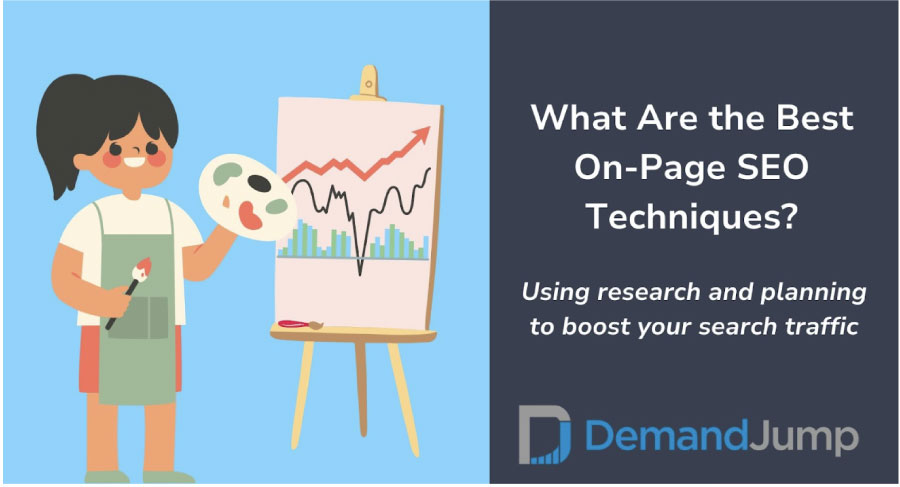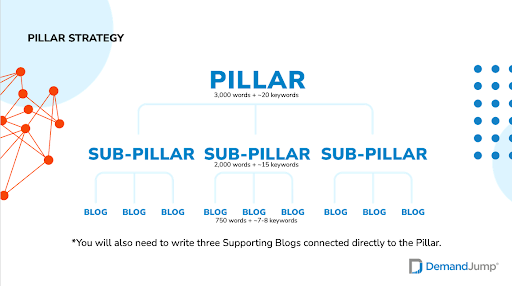What are the best on-page SEO techniques?
May 22, 2020 •DJ Team

The best on-page SEO techniques will center around keyword research, site layout, and creating helpful content. All of these are things you can work on today to improve your site rankings—and companies like DemandJump offer the tools and advisory services to make that process easy.
Whether you’re just getting started with SEO content, working on publishing some, or hoping to boost existing pages through content optimization, it can be tricky to know how to move forward. With so many methods of creating content and so many variables to consider, it can feel like there’s not really a clear path to success. But SEO doesn’t have to be a guessing game if you have the right data and use a few simple techniques that make your site easier to read, for both people and search engines.
There are many elements of SEO you can use to reach a wider audience organically—and a lot of them relate to on-page SEO. Keep reading to learn about the best on-page SEO factors to focus on and how to use site organization to set yourself apart from the noise. But first, let’s answer a couple of questions:
What Is On-Page SEO in Digital Marketing?
On-page SEO includes any SEO techniques and tools that focus on the actual web pages. The most popular example of this is keyword-driven content, but on-page SEO can also involve site navigation, image details, and even how a website’s individual pages connect with one another.
Why Is On-Page SEO Important?
On-page SEO is what makes your content easy to reference for search engines. It also is largely what drives the initial impressions your content gives readers. Many people know that good SEO helps people find your website for the first time, but what’s often overlooked is that on-page SEO can be what retains readers—what holds their interest and keeps them coming back for more.
What Are the Top 3 SEO Strategies?
While there’s no way to definitively say what the top three SEO strategies are, you can strategize around three key elements to guide your efforts:
- HTML
- Site Layout
- Helpful Content
You likely noticed that “keywords” didn’t make the cut, but don’t worry—we’ll talk about how to use keywords effectively once we get to “Helpful Content.” Another reason “keywords” isn’t on this list is that, frankly, most people already know they’re important, but very few focus on the three elements listed above. By creating a plan for these three, you will already be one step ahead of most content.
Strategy #1: Use Your HTML Wisely
HyperText Markup Language (HTML) is more than the code that makes your website load properly; it’s also another opportunity to make your content easier to find. Just as you embed language in your code to alter how your pages look, you can embed key words and phrases in your content that tell search engines “this is the right content to show people.” For example:
- Knowing when to use headers (and keywords as headers) makes your content far easier to skim.
- Meta descriptions provide a succinct summary of your page that crawlers can reference.
- Adding appropriate alt text to your images increases your chances to show in image searches.
It’s true these are small details, but doing the little things right can make a big difference for content.
Strategy #2: Optimize Site Layout
While this technically falls more into, well, technical SEO, site layout connects closely to on-page SEO too. If your web pages load slowly, are difficult to find, or don’t coherently connect, you’re leaving a lot of clicks on the table. There are several simple ways to improve your site that don’t require expertise:
- Strategically connecting your content with internal links makes for an easy, natural flow through your catalog. Strategies like Pillar-Based Marketing (PBM) create a clear hierarchy for web pages, funneling readers through your content in a way that matches their buyer journey.
- Make sure your pages have a mobile-friendly layout. A majority of internet users surf the internet on their mobile devices, so if you neglect this step, you’re already alienating most people online.
Strategy #3: Create Helpful Content
If you create something that provides value to readers, they’re far more likely to come back to you—and that’s exactly what helpful content does. And when we say content should be “helpful,” we mean that it needs to answer the searcher’s intent. On that note:
- As you do your keyword research, consider what type of keywords are showing up; this will give you clues about your audience. For example, someone who looks up “content optimization” is in a much different stage of learning than “what are the best content optimization tools?” Proven SEO strategies like Pillar Based Marketing (PBM) will make use of these various stages by funneling readers through your content based on where they are in their learning journey.
- Match your language to your readers’ language. Many brands will disregard certain keywords because they don’t exactly match the “branding” or specific phrasing they use for their specialties. This is a huge mistake, and an easy way to shut down your SEO efforts before they even get started. While your content should obviously showcase your brand identity, the primary goal with content should be to connect with readers and show them the value you can provide.
Creating helpful content is also about structure—that is, organizing and connecting individual content pieces together in a way that makes sense for your audience. PBM structure is one way to effectively unify your content and entice readers to keep clicking through your site.
How Does PBM Structure Work?
PBM uses three layers of content, with Pillars at the top, Sub-Pillars in the middle, and Supporting Blogs on the bottom. The title of each piece is a keyword that’s relevant to the chosen topic.
- A Pillar Page is the largest piece of content in a PBM strategy. This 3,000-word guide focuses on a broad topic with a high amount of traffic, and gives your audience the answers to the largest questions about said topic. They’re meant to be a general article that the other content falls under and connects to. Pillars need about 20 keywords and phrases for the best results.
- Sub-Pillars are the middle child of PBM, at 2,000 words and around 15 keywords. Their purpose is to focus on a topic less general than the Pillar by answering more specific, pointed questions. Sub-Pillars link directly back to the Pillar.
- Supporting Blogs are the shortest pieces of content at 750 words with 7-8 keywords. They answer very specific questions about a topic. Blogs link up to Sub-Pillars and Pillars.
So what does a PBM strategy look like? Here’s an example image of what a typical Pillar plan looks like:

While this diagram may appear linear, the reader journey through a Pillar plan can take any number of directions. As an example, let’s say the above diagram represents a Pillar plan for the topic “SEO strategy.” A reader may:
- Start by searching “What are the types of SEO?” then come across the Supporting Blog with that very title (“What Are the Types of SEO?”). From there, they might…
- Read the piece until they see a link in the copy for the associated Sub-Pillar (“SEO Strategy in Digital Marketing”). This grabs their interest yet again, and they read on until they see a hyperlink to learn more about “SEO Strategy”…
- …which would then lead them to the Pillar Page (“SEO Strategy”). From here, they could read a full-fledged guide on SEO strategy as a whole, which would give them more context for the Supporting Blog they started with in Step 1.
This is just one example of a journey readers might take. They may also go straight to the Pillar after finding the Supporting Blog if they’re in need of more base-level knowledge, or bounce between multiple articles to get all the information they want. Remember, just because they started with the question “what are the types of SEO?” doesn’t mean that’s all they’re curious about regarding SEO.
Structuring your content for easy navigation is arguably just as important as picking good keywords. If there is a logical chain of connections between your work, a reader is enticed to stay on your website longer and skim through multiple pieces in one sitting.
What Is an SEO Strategy Platform That Works? Try DemandJump
Even with the most relevant or current SEO parameters, companies may still need a hand in creating content that engages and inspires audiences. That’s where DemandJump comes in! We provide you with a variety of SEO tools and keywords that will own the first page of search engine results. Plus, our Insight Reports and analytics let you know what’s working and what’s not, so you can always find ways to improve. If you’re ready to leap to page one, try our platform for free today!
Featured Articles
Categories
- Attribution Tracking (13)
- Channel Optimization (11)
- Consumer Insights (68)
- Content Marketing (251)
- Data Science (8)
- Digital Marketing (6)
- Digital Transformation (26)
- Enterprise (10)
- Lead Generation (14)
- Market Intelligence (8)
- Marketing Analytics (39)
- Marketing Attribution (57)
- Marketing Management (153)
- Marketing Operations (86)
- Organic Search (222)
- Paid Search (52)
- Pillar-Based Marketing (63)
- Programmatic Advertising (9)
- SaaS Content (14)
- SaaS Marketing (29)
- Search Marketing (111)
- SEO Keyword Research (28)
- SEO Pillar (18)
- SEO Strategy (46)
- SMB (5)
- Website Content (12)


